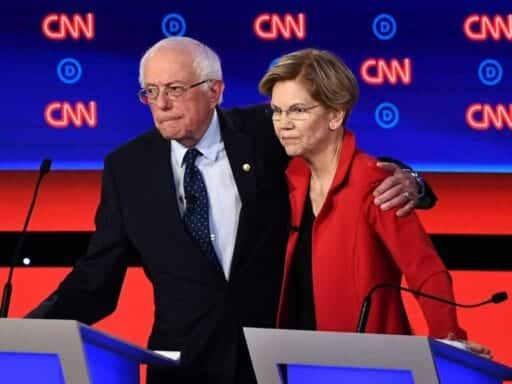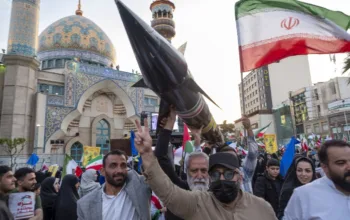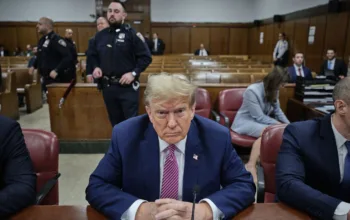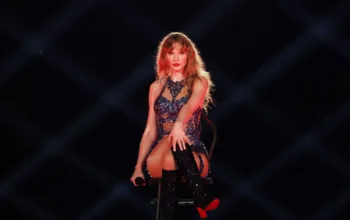All the top candidates will be onstage together for the first time.
The third Democratic debate — and the first to feature all the major candidates onstage together — will be a three-hour extravaganza taking place this Thursday, September 12, from 8 pm to 11 pm ET in Houston, Texas, and broadcast on ABC.
Because the DNC set stricter standards for qualification this time around, this debate will feature just 10 candidates on one night. Joe Biden, Elizabeth Warren, Bernie Sanders, Kamala Harris, Pete Buttigieg, Andrew Yang, Cory Booker, Beto O’Rourke, Amy Klobuchar, and Julián Castro will be onstage.
The stage will still be as crowded as it was on any individual night of the previous two debates. The difference is that all the top-polling candidates have chances to interact — some for the first time.
It’s particularly noteworthy that this is the first time Joe Biden and Elizabeth Warren will be onstage together. Due to the vagaries of random drawings, they were assigned to different nights for both of the first two debates. In addition to being one of Biden’s top challengers in polls, Warren has also had longstanding policy disagreements with Biden, dating back to a 2005 bill that made it more difficult for people to file for bankruptcy. So this is the first time their dueling visions for the Democratic Party’s future will be contrasted onstage.
Biden, in fact, will be standing right between Warren and Bernie Sanders. That will create an interesting dynamic, as the frontrunner will be in between the two major candidates who have eschewed big-dollar fundraising and who want to push the party much further to the left on economic issues.
This isn’t a do-or-die debate for any participant; in fact, everyone who qualified is guaranteed an invitation to return for the next Democratic debate in mid-October. Still, the current conventional wisdom (reflecting the current polls) is that Biden, Warren, and Sanders are the three top contenders at this point. So the other seven candidates know that, at some point, they need to make some more progress.
Where the Democratic race stands before the September debate
The frontrunner is still the frontrunner: All year, former Vice President Joe Biden has been leading national polls of the Democratic primary. The size of that lead has varied a bit, but no one has ever come close to topping Biden in RealClearPolitics’ average, where he’s currently polling at 30 percent support, putting him more than 10 points ahead of his nearest challengers.
All year, also, there have been long-running questions about Biden’s candidacy. Can he defend his long record to a changing Democratic electorate? Is his age showing? Is his poll standing based more on Obama nostalgia and name recognition than his present-day performance? Will he stumble in the Iowa caucuses or New Hampshire primary?
All those questions only deepened over the summer, with particular attention on various gaffes and misstatements by the candidate. And still, no one has yet managed to dislodge him from his place at the top of the polls. So Biden remains the man to beat — which means he may be the main target at the debate.
Warren and Sanders are about tied for second: The next tier beyond Biden is clear enough — it features Warren and Sanders, who are about tied. That is to say: not Kamala Harris, not Pete Buttigieg, and not anyone else in the enormous field.
Warren and Sanders are the only two other candidates who consistently poll in double digits, nationally, with both currently averaging around 18 percent support, per RCP.
But they got there through different paths. Sanders started the year as the second-place contender behind Biden. Warren, though, has so far gradually grown her support over the course of 2019. For instance, Sanders’s support is now about the same as it was in early June, while Warren’s has doubled since then.
Neither candidate has been a flash in the pan; at this point, it’s clear that both have built up devoted, loyal followings. Rep. Seth Moulton (D-MA), who ended his own presidential bid last month, opined afterward that “this is now a three-way race between Biden, Warren, and Sanders.” There’s still time for that to change, but lately, it’s been pretty consistent.
Harris and Buttigieg have declined from their peaks: The other two candidates who round out the top five have seen better days. California Sen. Kamala Harris surged after her tense confrontation with Biden after the first debate in late June. But since then, her poll level has returned to about where it was before that debate: She’s currently at 7 percent, a distant fourth place.
South Bend, Indiana, Mayor Pete Buttigieg, meanwhile, peaked back in April, as many Democratic voters were first learning who he was. Though he’s raised a ton of money since, he’s down to 4.3 percent support nationally, barely ahead of businessman Andrew Yang, New Jersey Sen. Cory Booker, and former Texas Rep. Beto O’Rourke (who are all in the 2 to 3 percent range). The early states are a bit more promising for Buttigieg, but not much.
The other contenders onstage are all still waiting for a breakout moment: Yang, Booker, O’Rourke, Minnesota Sen. Amy Klobuchar, and former HUD Secretary Julián Castro will make up the rest of the linuep this Thursday. Each remains mired in the low single digits in polls.
But at least they qualified — which is more than you can say for the other 10 candidates in the race, who failed to satisfy the DNC’s not particularly stringent requirement of getting 2 percent in at least four approved polls and also having 130,000 unique donors.
Therefore, the following candidates were excluded from participation in this debate: billionaire Tom Steyer, Hawaii Rep. Tulsi Gabbard, author Marianne Williamson, Montana Gov. Steve Bullock, Colorado Sen. Michael Bennet, New York City Mayor Bill de Blasio, former Maryland Rep. John Delaney, Miramar Mayor Wayne Messam, and former Pennsylvania Rep. Joe Sestak.
However, there’s an interesting twist about qualifying for the fourth Democratic debate in October: It will actually be easier. That’s because the qualification rules are exactly the same as for the third debate — except there will be more time for campaigns to make it happen (until October 1). So all 10 candidates who will participate in September’s debate automatically get invited back. And at least one other candidate, billionaire Tom Steyer, has already qualified to join them.
This week’s tougher debate qualification rules did appear to winnow the crowded Democratic field somewhat — Moulton, former Colorado Gov. John Hickenlooper, and New York Sen. Kirsten Gillibrand all quit the race when it became clear they wouldn’t qualify. So the next round of winnowing may take place after the October 1 cutoff for debate No. 4, as other candidates decide to throw in the towel.
Author: Andrew Prokop
Read More



